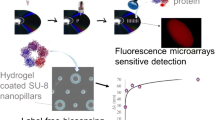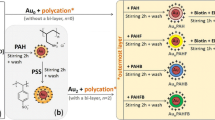Abstract
Conjugated polyelectrolytes (CPEs), with electron-delocalized backbones and charged ionic side chains, are unique sensory materials for the construction of optical biosensors. In this feature article, CPE-based visual detection of heparin is summarized. Three CPE-based heparin probes, including ratiometric, light-up and colormetric probes, are discussed in terms of molecular design, detection selectivity and quantification capability. The work summarized here provides fundamental guidelines for CPE-based label-free visual sensing.
Similar content being viewed by others
References
Pinto MR, Schanze KS. Conjugated polyelectrolytes: Synthesis and applications. Synthesis, 2002, 1293–1309
Duarte A, Pu KY, Liu B, Bazan GC. Recent advances in conjugated polyelectrolytes for emerging optoelectronic applications. Chem Mater, 2011, 23: 501–515
Hoven CV, Garcia A, Bazan GC, Nguyen TQ. Recent applications of conjugated polyelectrolytes in optoelectronic devices. Adv Mater, 2008, 20: 3793–3810
Huang F, Wu HB, Cao, Y. Water/alcohol soluble conjugated polymers as highly efficient electron transporting/injection layer in optoelectronic devices. Chem Soc Rev, 2010, 39: 2500–2521
Thomas SW III, Joly GD, Swager TM. Chemical sensors based on amplifying fluorescent conjugated polymers. Chem Rev, 2007, 107: 1339–1386
Nilsson KPR, Hammarström P. Luminescent conjugated polymers: illuminating the dark matters of biology and pathology. Adv Mater, 2008, 20: 2639–2645
Feng XL, Tang YL, Duan XR, Liu LB, Wang S. Lipid-modified conjugated polymer nanoparticles for cell imaging and transfection. J Mater Chem, 2010, 20: 1312–1316
Pu KY, Li K, Liu B. A molecular brush approach to enhance quantum yield and suppress nonspecific interactions of conjugated polyelectrolyte for targeted far-red/near-infrared fluorescence cell imaging. Adv Funct Mater, 2010, 20: 2770–2777
Pu KY, Li K, Shi JB, Liu B. Fluorescent single-molecular core-shell nanospheres of hyperbranched conjugated polyelectrolyte for live-cell imaging. Chem Mater, 2009, 21: 3816–3822
Liu B, Bazan, GC. Homogeneous fluorescence-based DNA detection with water-soluble conjugated polymers. Chem Mater, 2004, 16: 4467–4476
Pu KY, Liu B. Optimizing the cationic conjugated polymer-sensitized fluorescent signal of dye labeled oligonucleotide for biosensor applications. Biosens Bioelectron, 2009, 24: 1067–1073
Gaylord BS, Heeger AJ, Bazan GC. DNA detection using water-soluble conjugated polymers and peptide nucleic acid probes. Proc Natl Acad Sci USA, 2002, 99: 10954–10957
Liu B, Baudrey S, Jaeger L, Bazan GC. Characterization of TectoRNA assembly with cationic conjugated polymers. J Am Chem Soc, 2004, 126: 4076–4077
Pu KY, Liu B. Intercalating dye harnessed cationic conjugated polymer for real-time naked-eye recognition of double-stranded DNA in serum. Adv Funct Mater, 2009, 19: 2770–2777
Duan XR, Liu LB, Feng FD, Wang S. Cationic conjugated polymers for optical detection of DNA methylation, lesions, and single nucleotide polymorphisms. Acc Chem Res, 2010, 43: 260–270
Pu KY, Pan SYH, Liu B. Optimization of Interactions between a cationic conjugated polymer and chromophore-labeled DNA for optical amplification of fluorescent sensors. J Phys Chem B, 2008, 112: 9295–9300
Feng XL, Liu LP, Wang S, Zhu DB. Water-soluble fluorescent conjugated polymers and their interactions with biomacromolecules for sensitive biosensors. Chem Soc Rev, 2010, 39: 2411–2419
Wang C, Zhan RY, Pu KY, Liu B. Cationic polyelectrolyte amplified bead array for DNA detection with zeptomole sensitivity and single nucleotide polymorphism selectivity. Adv Funct Mater, 2010, 20: 2597–2604
Nilsson KPR, Rydberg J, Baltzer L, Inganäs O. Self-assembly of synthetic peptides control conformation and optical properties of a zwitterionic polythiophene derivative. Proc Natl Acad Sci USA, 2003, 110: 10170–10174
Li K, Liu B. Water-soluble conjugated polymers as the platform for protein sensors. Polym Chem, 2010, 1: 252–259
Ho HA, Najari A, Leclerc M. Optical detection of DNA and proteins with cationic polythiophenes. Acc Chem Res, 2008, 41: 168–178
Feng FD, He F, An LL, Wang S, Li YL, Zhu DB. Fluorescent conjugated polyelectrolytes for biomacromolecule detection. Adv Mater, 2008, 20: 2959–2964
Wang YY, Liu B. Conjugated polymer as a signal amplifier for novel silica nanoparticle-based fluoroimmunoassay. Biosen Bioelectron, 2009, 24: 3293–3298
Wang J, Liu B. Fluorescence resonance energy transfer between an anionic conjugated polymer and a dye-labeled lysozyme aptamer for specific lysozyme detection. Chem Commun, 2009, 17: 2284–2286
Achyuthan KE, Bergstedt TS, Chen L, Jones RM, Kumaraswamy S, Kushon SA, Ley KD, Lu L, McBranch D, Mukundan H, Rininsland F, Shi X, Xia W, Whitten DG. Fluorescence superquenching of conjugated polyelectrolytes: Applications for biosensing and drug discovery. J Mater Chem, 2005, 15: 2648–2656
Herland A, Inganäs O. Conjugated polymers as optical probes for protein interactions and protein conformations. Macromol Rapid Commun, 2007, 28: 1703–1713
Li C, Numata M, Takeuchi M, Shinkai S. A sensitive colorimetric and fluorescent probe based on a polythiophene derivative for the detection of ATP. Angew Chem Int Ed, 2005, 44: 6371–6374
Maynor MS, Nelson TL, Sullivan CO, Lavigne JJ. A food freshness sensor using the multistate response from analyte-induced aggregation of a cross-reactive poly(thiophene). Org Lett, 2007, 9: 3217–3220
Yao Z, Li C, Shi G. Optically active supramolecular complexes of water-soluble achiral polythiophenes and folic acid: Spectroscopic studies and sensing applications. Langmuir, 2008, 24: 12829–12835
Xue C, Cai F, Liu H. Ultrasensitive fluorescent responses of water-soluble, zwitterionic, boronic acid-bearing, regioregular head-to-tail polythiophene to biological species. Chem Eur J, 2007, 14: 1648–1653
Chen LH, McBranch DW, Wang HL, Helgeson R, Wudl F, Whitten DG. Highly sensitive biological and chemical sensors based on reversible fluorescence quenching in a conjugated polymer. Proc Natl Acad Sci USA, 1999, 96: 12287–12292
Wang DL, Gong X, Heeger PS, Rininsland F, Bazan GC, Heeger AJ, Fluorescent-conjugated polymer superquenching facilitates highly sensitive detection of proteases. Proc Natl Acad Sci USA, 2002, 109: 49–53
Pinto MR, Schanze KS. Amplified fluorescence sensing of protease activity with conjugated polyelectrolytes. Proc Natl Acad Sci USA, 2004, 101: 7505–7510
Swager TM. The molecular wire approach to sensory signal amplification. Acc Chem Res, 1998, 31: 201–207
Kim J, McQuade DT, McHugh SK, Swager TM. Ion-specific aggregation in conjugated polymers: Highly sensitive and selective fluorescent ion chemosensors. Angew Chem Int Ed, 2000, 39: 3868–3872
Pu KY, Li K, Zhang XH, Liu B. Cationic oligofluorene-substituted polyhedral oligomeric silsesquioxane as light-harvesting unimolecular nanoparticle for fluorescence amplification in cellular imaging. Adv Mater, 2010, 22: 643–646
Liu B, Gaylord BS, Wang S, Bazan GC. Effect of chromophore-charge distance on the energy transfer properties of water-soluble conjugated oligomers. J Am Chem Soc, 2003, 125: 6705–6714
Pu KY, Zhan RY, Liu B. Conjugated polyelectrolyte blend as perturbable energy donor-acceptor assembly with multicolor fluorescence response to proteins. Chem Commun, 2010, 46: 1470–1472
Pu KY, Shi JB, Wang LH, Cai LP, Wang G, Liu B. Manose-substituted conjugated polyelectrolyte and oligomer as an intelligent energy transfer pair for label-free visual detection of concanavalin A. Macromolecules, 2010, 43: 9690–9697
Gaylord BS, Heeger AJ, Bazan GC. DNA hybridization detection with water-soluble conjugated polymers and chromophore-labeled single-stranded DNA. J Am Chem Soc, 2003, 125: 896–900
Ho HA, Boissinot M, Bergeron MG, Corbeil G, Doré K, Boudreau D, Leclerc M. Colorimetric and fluorometric detection of nucleic acids using cationic polythiophene derivatives. Angew Chem Int Ed, 2002, 41: 1548–1551
Tang YL, Feng FD, He F, Wang S, Li YL, Zhu DB. Direct visualization of enzymatic cleavage and oxidative damage by hydroxyl radicals of single-stranded DNA with a cationic polythiophene derivative. J Am Chem Soc, 2006, 128: 14972–14976
Fan QL, Zhou Y, Lu XM, Hou XY, Huang W. Water-soluble cationic poly(p-phenyleneethynylene)s (PPEs): Effects of acidity and ionic strength on optical behaviour, Macromolecules, 2005, 38: 2927–2936
Wang J, Wang D, Miller EK, Moses D, Bazan GC, Heeger AJ. Photoluminescence of water-soluble conjugated polymers: Origin of enhanced quenching by charge transfer. Macromolecules, 2000, 33: 5153–5158
Wang YY, Liu B. Cationic water-soluble polyfluorene homopolymers and copolymers: Synthesis, characterization and their applications in DNA Sensing. Curr Org Chem, 2011, 15: in press
Capila I, Linhardt RJ. Heparin-protein interactions. Angew Chem Int Ed, 2002, 41: 390–412
Whitelock JM, lozzo RV. Heparan sulfate: A complex polymer charged with biological activity. Chem Rev, 2005, 105: 2745–2764
Pu KY, Liu B. A multicolor cationic conjugated polymer for naked-eye detection and quantification of heparin. Macromolecules, 2008, 41: 6636–6640
Shi J, Pu KY, Zhan R, Liu B. Cationic conjugated polymer/heparin interpolyelectrolyte complexes for heparin quantification. Macromol Chem Phys, 2009, 210: 1195–1200
Lakowicz JR. Principles of Fluorescence Spectroscopy. New York: Kluwer Academic/Plenum, 1999
Pu KY, Cai L, Liu B. Design and synthesis of charge-transfer-based conjugated polyelectrolytes as multicolor light-up probes. Macromolecules, 2009, 42: 5933–5940
Pu KY, Liu B. Fluorescence turn-on responses of anionic and cationic conjugated polymers toward proteins: Effect of electrostatic and hydrophobic interactions. J Phys Chem B, 2010, 114:3077–3084.
Pu KY, Liu B. Conjugated polyelectrolytes as light-up macromolecular probes for heparin sensing. Adv Funct Mater, 2009, 19: 277–284
Garreau S, Leclerc M, Errien N, Louarn G. Planar-to-nonplanar conformational transition in thermochromic polythiophenes: A spectro scopic study. Macromolecules, 2003, 36:692–697
Zhan RY, Fang Z, Liu B. Naked-eye detection and quantification of heparin in serum with a cationic polythiophene. Anal Chem, 2010, 82: 1326–1333
Langeveld-Voss BMW, Janssen RAJ, Christiaans MPT, Meskers SCJ, Dekkers H, Meijer EW. Circular dichroism and circular polarization of photoluminescence of highly ordered poly3,4-di[(S)-2-methyl-butoxy]thiophene. J Am Chem Soc, 1996, 118: 4908–4909
Raymond PD, Ray MJ, Callen SN, Marsh NA. Hemostatic monitoring for cardiothoracic surgery patients: conclusions. Perfusion, 2003, 18: 269–276
Boneu B, de Moerloose P. How and when to monitor a patient treated with low molecular weight heparin. Semin. Thromb Hemost, 2001, 27: 519–522
Guo JD, Yuan Y, Amemiya S. Voltammetric detection of heparin at polarized blood plasma/1,2-dichloroethane interfaces. Anal Chem, 2005, 77: 5711–5719
Mathison S, Bakker E. Renewable pH cross-sensitive potentiometric heparin sensors with incorporated electrically charged H+ ionophores. Anal Chem, 1999, 71: 4614–4621
Langmaier J, Samcová E, Samec Z. Potentiometric sensor for heparin polyion: Transient behavior and response mechanism. Anal Chem, 2007, 79: 2892–2900
Gemene KL, Meyerhoff ME. Reversible detection of heparin and other polyanions by pulsed chronopotentiometric polymer membrane electrode. Anal Chem, 2010, 82: 1612–1615
Wang SL, Chang YT. Discovery of heparin chemosensors through diversity oriented fluorescence library approach. Chem Commun, 2008, 1173–1175
Wang M, Zhang DQ, Zhang GX, Zhu DB. The convenient fluorescence turn-on detection of heparin with a silole derivative featuring an ammonium group. Chem Commun, 2008, 4469–4471
Sauceda JC, Duke RM, Nitz M. Designing fluorescent sensors of heparin. ChemBioChem, 2008, 8: 391–394
Zhong ZL, Anslyn, EV. A colorimetric sensing ensemble for heparin. J Am Chem Soc, 2002, 124: 9014–9015
Wright AT, Zhong ZL, Anslyn EV. A functional assay for heparin in serum using a designed synthetic receptor. Angew Chem Int Ed, 2005, 44: 5679–5682
Egawa Y, Hayashida R, Seki T, Anzai J. Fluorometric determination of heparin based on self-quenching of fluorescein-labeled protamine. Talanta 2008, 76: 736–41
Mecca T, Consoli GML, Geraci C, La Spina R, Cunsolo F. Polycationic calix[8]arenes able to recognize and neutralize heparin. Org Biomol Chem, 2006, 4: 3763–3768
Sun W, Bandmann H, Schrader T. A fluorescent polymeric heparin sensor. Chem Eur J, 2007, 13: 7701–7707
Jagt RBC, Gomez-Biagi RF, Nilz M. Pattern-based recognition of heparin contaminants by an array of self-assembling fluorescent receptors. Angew Chem Int Ed, 2009, 48: 1995–1997
Author information
Authors and Affiliations
Corresponding author
Rights and permissions
About this article
Cite this article
Pu, K., Zhan, R., Liang, J. et al. Conjugated polyelectrolytes for label-free visual detection of heparin. Sci. China Chem. 54, 567–574 (2011). https://doi.org/10.1007/s11426-011-4241-y
Received:
Accepted:
Published:
Issue Date:
DOI: https://doi.org/10.1007/s11426-011-4241-y




